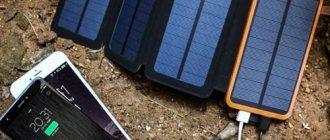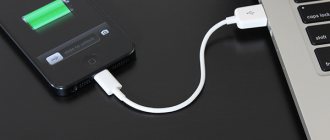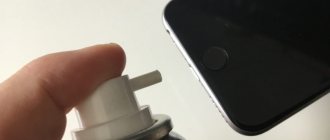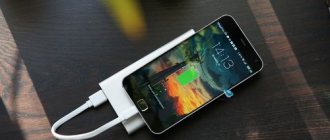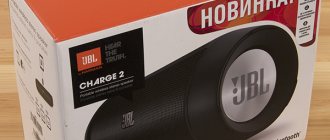Charger (CH) - transfers energy to gadget batteries from external sources and thereby ensures long-term and uninterrupted operation of phones, tablets, laptops, e-readers, mp3 players and other equipment.
All gadgets are usually equipped with “native” memory. However, during operation the need for additional memory arises. Another factor in favor of such devices is the fact that most modern devices do not require replacing one battery with another (with the exception of cameras).
- Network storage
- Wireless storage
- Car storage
View
Network (stationary, SZU) – charges the gadget from the mains (220 V). It may be “native” for certain models or simply an adapter for connecting a USB connector to the mains. The SPS is relatively inexpensive and has no restrictions on energy resources, but depends on the availability of the network.
Wireless – works based on the principle of magnetic induction and transmits energy directly to the phone/tablet without connecting a cable. It is made in the form of a platform on which the gadget is placed. The wireless charging pad itself is connected using a cable to the network or to another device (computer, laptop) via a USB port.
The wireless charger is easy to use, safe (no contact with electricity) and can be used in difficult conditions. Also, using a wireless charger allows you to do without cables, and the connectors do not wear out.
Disadvantages of wireless chargers: high price, long charging time, during which the phone/tablet cannot be fully used. In addition, such devices are not suitable for every phone.
Most wireless chargers are universal, that is, compatible with models of different brands.
Automotive (AZU) – charges the gadget from the car’s on-board network and connects to the cigarette lighter. It is made in the form of a cable or adapter, often cylindrical in shape with USB connectors for devices. This charger can only be used in a car. The ASU is perfect for people who constantly drive.
Docking station – makes it easy to charge mobile devices. At the same time, the smartphone/tablet is in a vertical position, which allows you to comfortably play games, watch movies, and communicate while charging. Some models are capable of powering several gadgets at the same time, for example, a smartphone, smart watch and headphones.
The kit consists of several chargers, for example, a network charger and a car charger. Makes it possible to charge portable devices anywhere – on the road, in the office or at home.
A cigarette lighter splitter is a charger with multiple connectors that connects to the cigarette lighter. The number of connectors in a splitter means the number of gadgets that can be charged from the cigarette lighter at the same time. But it is worth taking into account the limitations on the total power of the connected load - otherwise the cigarette lighter may fail.
Conclusion
The article describes in detail how to find out the power of the charger. In most cases, it is enough to multiply the current value by the voltage indicated on the charging case. With support for multiple charging modes, the manufacturer will indicate 2 or 3 power values. Adapters with multiple ports on a case usually list the total wattage of all ports, but look for the wattage of a single port in the specification or instructions.
What questions do you have? Leave messages in the comments at the bottom of the article.
Post Views: 3,620
Wireless car
This charger is a holder that securely holds the smartphone and prevents it from falling while the car is moving. This memory makes it possible to use a smartphone as a navigator.
Methods for attaching a wireless charger:
- sticker – provides reliable fixation of the charger, but is designed for one-time use;
- a clothespin holder in the air duct is a reliable and simple method of fastening, it can be used multiple times, this option is most common;
- suction cup holder for windshield, dashboard - can be used an unlimited number of times, but is not suitable for attaching the charger to a textured surface.
Methods for attaching a smartphone to the ASU:
- mechanical (manual) clamp - a cheap and simple option, ensures compatibility with many device models;
- gravity clamp - compares favorably with the previous method with greater reliability and ease of operation;
- magnet is a reliable option, compatible with models of different sizes, but not suitable for devices that are too heavy;
- sensor clip – reacts to the approach of a person’s hand or portable device. The most convenient way to mount your smartphone. Cons: high price, dependence on nutrition.
Excess current
This situation occurs when the user charges the smartphone using the power supply from the tablet. Typically, the optimal current for charging tablet computers is 2 A, so such power supplies are not suitable for many budget phones. Despite the fact that modern smartphones have a built-in power controller, the battery may become very hot, which is extremely undesirable. If the charge current is greatly exceeded, the controller burns out.
It is recommended to use third-party adapters carefully and choose the right analogues, the characteristics of which will correspond to the original chargers.
Purpose
For phones, smartphones – equipped with one USB output for connecting relevant equipment. The output current is 1 A.
For tablets – equipped with one output for connecting a tablet. Output current – 2.1 A.
Important: the maximum current of 2.1 A is released only when one device is connected. If two devices are charging at the same time, the charger will “give” a current of 1 A. If you charge equipment rated for 2.1 A using a 1 A charger, it will take longer to charge.
Universal – compatible with smartphones, tablets, wireless headphones, e-readers, fitness bracelets and other portable equipment. Such models are equipped with several USB outputs for charging gadgets from one outlet. A good choice for those who travel frequently: you don’t have to take a charger with you for each device, but get by with one charger and a set of cables.
Universal chargers also include USB charging with multiple plugs. One end of the cable is connected (via a USB port) to a computer, laptop, or charger, and the other (via connectors) is connected to a gadget that needs to be recharged.
USB charging powers phones and smartphones of different brands, tablets, and cameras. Such a device is inexpensive, but its functionality is limited by the presence or absence of a computer, laptop, or ASD at hand.
Important: when using universal USB charging, you must take into account the input current parameter - the current in the devices from which the device is charged. This characteristic affects how quickly the connected device's battery charges. But not all power sources provide high current. For example, a PC USB port has an input current of 500 mA.
For smart watches - such chargers are mainly wireless and are made in the form of a round platform with a cable/USB connector for connecting to a device with such a connector.
Important: wrist devices use different charging technologies. Therefore, when purchasing a charger, pay attention to its compatibility with your smartwatch model.
Standalone PowerBanks for phones
Types of chargers
Structurally and according to the principle of operation, chargers are divided into two types - adapters themselves, they are also power supplies; and external chargers, better known as “power banks”.
Adapters or power supplies
Adapters are structurally conventional electrical converters that rectify and reduce voltage. Such devices are intended for charging a phone or smartphone from a household network. According to the results of the conversion, alternating current with a voltage of 220 V and a power of 5-6 A is “transformed” into direct current, whose parameters are 5-18 V and 0.5-2.1 A, depending on the characteristics and purpose of the adapter.
Adapters are made in the form of small blocks that are installed in a household outlet. A power cable is connected to them, through which the converted electric current is “transmitted” to the smartphone.
Structurally, adapters are divided into household adapters, intended for installation in a regular outlet, and automobile adapters, powered from a cigarette lighter or a corresponding socket. Despite the similar principle of operation, they are not interchangeable.
The main criteria when choosing an adapter are the input voltage parameters, output voltage, current strength and support for fast charging technologies.
It is worth mentioning separately another type of power supply – wireless chargers. Such devices recharge the smartphone that comes into contact with them. Of course, the smartphone itself must support wireless charging.
External batteries or power banks
External batteries, which can also be called portable chargers, power banks, etc., have the same operational purpose as power supplies - they are used to charge a smartphone. However, the operating principles of these devices are radically different.
The power bank is a high-capacity battery by design. It is complemented by various functional elements - charge controller, LED indicators, power connectors, buttons, etc. The operating principle of a power bank is as follows:
First, the external battery is charged from a power source (for example, from an adapter or a computer via a USB cable);
Then it “holds” the accumulated energy for some time;
When you connect a smartphone, the power bank releases accumulated energy to the connected device.
Essentially, the power bank is designed for emergency charging of a smartphone in conditions where it is impossible to get to an outlet or there is no time for it - when traveling, for example.
When choosing a power bank, you should take into account the following criteria: capacity, charge current, case material, support for fast charging technologies.
Compatibility
This parameter is used to evaluate whether the charger is suitable for a particular gadget. Chargers are divided into two categories.
- Branded – chargers with proprietary connectors that guarantee full compatibility of the two devices. Manufactured by manufacturers of portable equipment, for example, Apple, Nokia, Sony Ericsson. There are chargers from third-party manufacturers that are also suitable for gadgets of a particular brand. Branded chargers are rare.
- Universal – compatible with the vast majority of portable equipment from different brands through the use of standard USB connectors.
Design
MagSafe – charging for Apple gadgets. It is made in the form of a magnetic disk that is fixed on the back of the iPhone. Allows you to comfortably use the device while charging, including playing games.
Charging 1 smartphone – designed to charge one gadget (smartphone, less often a tablet). Some models can simultaneously charge a smartphone and a smartwatch.
Charging 2 smartphones – designed to charge two gadgets. Some devices are capable of charging 2 smartphones and a smartwatch. Compared to storage for one gadget, these models take up more space and are more expensive.
Headphone charging area – a special area for wireless charging of headphones.
Smartwatch charging area – a special design for wireless charging of smartwatches and other wrist devices.
What's the best way to charge your phone?
Many people argue about the best way to charge your phone. Some believe that you should use the wireless method, while others say that this is dangerous for the gadget and you should choose only a wire and only the original one.
There are not even any questions about originality. Both the power adapter and the cable must be original or just good. Options from AliExpress are not our method. I've heard stories many times about how the smartphone doesn't charge well, and they all said that something needs to be done with the charging socket. It never even occurred to anyone that the connector of an expensive smartphone is much more reliable than cables that are sold for 100 rubles per bucket. A bucket is also included in the price.
In addition to the fact that, due to poor wiring, the cable can short out and burn the phone, it can charge slowly. This is even more common than the fact that it simply does not work. A high-quality cable must be made of high-quality materials, and they cost money - this is an axiom.
We decided and fixed it - charging must be of high quality. Even an expensive charger will end up cheaper. Especially if you have a flagship smartphone. Now you need to understand which charger to choose for yourself. I chose two options.
Output connection
1x USB Type-C / 2x USB Type-C – a smaller version of the USB connector. It features a double-sided design, which allows you to connect the cable to the device the first time.
microUSB – often found in portable technology.
Lighting – used in Apple products (iPad, iPod touch, iPhone). Not applicable by other manufacturers. A similar connector is found in some universal chargers.
Proprietary connector - developed by a specific manufacturer exclusively for its products. You cannot connect a gadget from another manufacturer to this connector.
Types of charging connectors
Let's start with the connectors that are used in smartphones to charge them. Just a couple of decades ago, there were many types of charging connectors - every self-respecting manufacturer of mobile equipment considered it necessary to introduce its own standard.
In the 21st century, things began to change - manufacturers began to negotiate and introduce common standards. Now the list of connector types is small, but before going to the store, you will have to study it.
miniUSB
At the beginning of the 2000s, most mobile device manufacturers began to switch to miniUSB. This made it possible to use the socket not only for charging, but also for exchanging data with external devices. Nowadays you won’t find models with this type of interface in the store, but we still use the old ones with miniUSB.
microUSB
This type of connector appeared almost simultaneously with miniUSB and immediately began to displace the latter from the market. MicroUSB turned out to be more compact and, according to the developers, more durable. However, judging by user reviews, this statement is highly controversial. Today, the vast majority of smartphones come with a microUSB socket.
USB Type-C
A relatively young type of USB connector that has begun to be installed in laptops, tablets and smartphones. Five years ago, a device with such a connector was rare, but today most mobile gadgets come with a 24-pin USB-C socket. The only exceptions may be iPads and iPods from Apple, which does not want to negotiate standards with other manufacturers.
Healthy! Most recently, Apple released a MacBook with a USB-C interface, so it is quite possible that we will still be able to see smartphones from this manufacturer with a similar socket.
Lightning
As already noted, Apple is perhaps the only company that does not want to agree on common interface standards, but continues to equip its gadgets with unique connectors. One of the first to appear was a magnetic five-pin connector.
Almost simultaneously with him, the company began producing thirty-pin sockets, which, to put it mildly, were not entirely compact. The most modern was the eight-pin symmetrical connector. This type of plug can be inserted into the outlet in either direction.
Important! Note that the USB-C plug can be inserted into the corresponding socket either way.
From all of the above, we can conclude that one of the main criteria when choosing a charger remains the type of plug with which it is equipped. Otherwise, you will have to look for an appropriate adapter or replace the cable if it is removable.
Characteristics
Maximum output current
The highest current directed from the charger to the connected device. Measured in amperes (A). The higher the output current, the faster the device's battery will charge. But too high a setting can lead to overheating of the charger and the charging gadget and even to their breakdown. At low output current values, the charging speed will decrease. In different chargers it is 1-5 A.
Maximum Output Current (USB Type-C)
The highest output current indicated for a charger with a USB Type-C connector.
Output voltage
Measured in volts (V). This indicator must match the input voltage of the gadget being charged. For phones, tablets, headphones and smartwatches this value is usually 5 V, for video cameras - 9 V, for laptops - 16/19 V.
If the output voltage of the charger is higher than the input voltage of the receiver, this will lead to damage to the battery of the connected device and even to its explosion.
Output voltage (USB Type-C)
Output voltage, which is indicated for a memory device with a USB Type-C connector.
Maximum power per device
The maximum power that the charger delivers to one charged device. The larger this parameter, the faster the gadget’s battery will charge.
At the same time, the device being charged must support the appropriate power and, in some cases, fast charging technology. Depending on the charger model, the maximum power for 1 device is 5-18 W or more.
What current and voltage are needed?
Almost all smartphones, regardless of manufacturer and model, come with a 3.7 V battery. Thus, five volts is enough to charge them. An exception may be gadgets that support fast charging technology (more on this below), but even in this case, the smartphone can be charged with a five-volt adapter.
Now about the current strength - everything will depend on the capacity of the installed battery and the supported fast charging technologies. Typically, the charging current is 0.9–1.0 A for mid-range smartphones and 2.0–2.1 A for high-end flagship models. If we don’t know what current our particular gadget requires, then we can’t go wrong when choosing a charger with the maximum current. But if we have a “native” charger in our hands, then it is better to read its characteristics on the case markings and take the same one. This will allow you to save a lot of money, since powerful chargers are much more expensive, but do not increase charging time in any way.
Expert opinion
Alexey Bartosh
Specialist in repair and maintenance of electrical equipment and industrial electronics.
Ask a Question
Important! You can often hear that an overly powerful charger can burn out a gadget. If the output voltage of such a charger corresponds to what is needed for a smartphone, then nothing like this will happen, even if the charger is capable of delivering a current of 100 A. The mobile phone itself will deal with the current and take exactly as much as it needs.
Peculiarities
GaN charging is a charger based on gallium nitride (GaN). Compared to a classic charger, it charges faster and takes up less space, which is important when traveling. Compatible with all devices equipped with a USB Type-C port.
Operation indicator – informs about the operation of the charger. Allows you to evaluate whether the device is working correctly. Some devices are equipped with an indicator that displays information about failures and operating modes of the memory.
Apple MFI certification – certifies that third-party products for Apple gadgets comply with the technical standards of this company. Guarantees perfect compatibility of these accessories with iPhone/iPod/iPad.
Current standard for charging a phone
Most power supplies for phones produce a current of 1-2 A - this indicator is specially selected by manufacturers. It allows you to fill the battery with energy relatively quickly and does not cause harmful overheating of the device. Typically, the current indicator is indicated on the charger body. You can also take measurements yourself with a modern ammeter. It is often sold under the name "charging tester" and is easy to use - just connect the charging output cable to the device, and the latter will display the desired parameters.
Cable
The cable comes in several types:
- direct - a cheap and simple option, but not very convenient;
- twisted - rolled into a spring, such a cable is more compact in the absence of tension;
- in the form of a tape measure - takes up minimal space;
- built-in - attached to the charger body and located in a special niche. Although this cable is relatively small, it is more convenient than other analogues, since it will not get lost.
The cable length varies: less than 50 cm, 50-100 cm, 100-200 cm. It is determined by the distance from the power source to the charger. A cable that is too short or too long will create inconvenience when operating the charger. In most cases, a length of 50-100 cm will be sufficient. For ASU, a length of less than 50 cm is suitable.
Important: pay attention to the quality of the cable, as it affects the charging speed of the gadget. A good cable should not allow any drop in output current or voltage. Also, the low charging speed can be explained by the long length or small cross-section of the cable.
How to choose an external charger
When choosing a power bank, you should pay attention to three parameters:
But the first two are the most important.
Capacity
The higher the capacity of the power bank, the more times it can recharge a dead smartphone. However, the actual value of this number is determined by the battery capacity of the smartphone.
For example, if the smartphone is equipped with a 3000 mAh battery:
A 5000 mAh power bank will recharge it once;
A 10,000 mAh power bank will recharge it 2-2.5 times;
A 20,000 mAh power bank will recharge it 5-6 times.
However, the exact number depends on a number of other parameters, including the charge current, the resistance of the connected cable, the weather outside, the time elapsed since charging and many others. Therefore, you should not hope that, for example, a 5000 mAh power bank will be able to recharge a smartphone with a 2500 mAh battery twice.
Charge current
The charge current value should be selected based on the same parameters as for conventional network adapters (power supplies). Considering that the stability of the current in power banks is not too high, it is worth choosing deliberately inflated parameters:
For mobile phones, old smartphones, players, smart watches, wireless headphones and other gadgets that do not consume high power during operation - 1 A;
For modern smartphones, tablets, low-power laptops - 2-2.5 A.
There are several models of power banks that support fast charging technologies. As a result, it is worth considering the compatibility of the charger and the smartphone with which it is planned to be used.
However, power banks that support fast charging technologies are not recommended for purchase. The batteries built into them usually “do not survive” the “squeezing” of 20 V/5 A from them. Therefore, the battery capacity drops, and after a few months you will have to change the power bank.
Housing material
The strength, durability and some operational characteristics of the power bank depend on the material of the case. Such devices can be made of plastic, metal, and also supplemented with rubberized inserts.
Plastic is a simple, inexpensive, but quite reliable material. Power banks with such a case are cheaper than metal ones, but at the same time they do not survive being dropped on the floor. However, plastic has an important advantage - external chargers made of this material are better able to withstand temperature changes during the cold season.
Metal is better able to withstand any falls and other mechanical impacts. However, power banks in such cases are a little more expensive. In addition, due to the fact that metal “accumulates” low temperatures, such devices self-discharge faster during the cold season.
Additional inserts - for example, rubber ones - either protect the power bank from shock impacts, or simply make it more beautiful.
Fast charge
Makes it possible to significantly reduce charging time. Involves charging at higher current and voltage levels compared to standard mode. In this case, the charger and the device connected to it must support charging technology and the corresponding current and voltage parameters.
Quick Charge, developed by Qualcomm, is the most common standard used in Android smartphones. Other fast charging standards: TurboPower (Lenovo, Motorola), Adaptive Fast Charging (Samsung), Power Delivery (Apple), Super Charge (Huawei), Pump Express (MediaTek), Super mCharge (Meizu), VOOC Flash Charging (OPPO), Dash Charge (One Plus).
Fast charging standards parameters (voltage and power):
- Quick Charge 2.0 – 5V, 9V, 12V and 20V, up to 15 W;
- Quick Charge 3.0 –3.2-20V (0.2 V steps), up to 15 W;
- Quick Charge 4.0 – 5-24V, up to 15W;
- TurboPower – 5V, 9V and 12V, 25.8 W;
- Adaptive Fast Charging – 5V and 9V, 15 W;
- Power Delivery – 5V, 12V and 20V, 100 W;
- Super Charge – 5V, 22.5 W;
- Pump Express – 9V and 12V, up to 18 W;
- Super mCharge – 11V, 55 W;
- VOOC Flash Charging – 5V, 25W;
- Dash Charge – 5V, 20W.
To date, there is no consensus on how harmful fast charging is. Some users claim that this mode has almost no effect on battery wear, while others do not agree with this point of view. In any case, it is not recommended to use fast charging very often.
What is fast charging for iPhone?
iPhones support USB Power Delivery. Its advantage is compatibility with a large number of devices, the second most popular standard after Qualcomm Quick Charge. With it, iPhone is supported by third-party accessories.
However, this advantage is broken by the proprietary nature of the Lightning connector.
Let us remind you that Apple smartphones support fast charging starting with the 2022 models (8, Plus and X). Starting with the iPhone 11 Pro, the Cupertino company has included fast charging in the box for its flagships.
To increase speed, the connector on the adapter was changed - instead of USB-A there is USB-C. However, even with it, iPhones cannot compete with the best.
Adapter power - 18 Watt. According to PhoneArena, the iPhone 11 Pro charges 28% in 15 minutes, 55% in half an hour, 85% in an hour, and 1 hour 42 minutes to fully charge. Decent relative to regular, 5-watt charging and generally compared to the competition.
Similar indicators are found in OnePlus 5T, a 2017 smartphone. OnePlus 7 Pro leaves no chance for the iPhone - with a larger battery, the flagship with a retractable camera is fully charged in less than an hour.
Almost two hours to fully charge is too mediocre. The same OnePlus 5T completely replenished energy in an hour and a half.
USB Power Delivery is also supported by Google Pixel and some Sony smartphones. For example, last year's Xperia XZ3. The Pixel 3 and 3 XL also have a maximum charging power of 18 Watts.
Adviсe
- The price of a charger depends not only on the material, capacity, build quality, but also on the manufacturer. You should not purchase cheap chargers from unknown brands, as they can not only quickly fail, but also damage the battery of the device being charged.
- In cheap chargers, the case material is made of lightweight plastic, while more expensive devices have a durable metal case (most often aluminum).
- The memory must be intact and free of defects. Otherwise, it will simply be useless.
- After fully charging your phone/tablet or other equipment, it is recommended to disconnect the charger from the mains. This will save electricity and not harm the gadget’s battery (overcharging will reduce its service life).
- Do not allow the electronic device to completely discharge before charging it with a battery charger. The best result is achieved when the electronic device is not charged “from scratch”, but recharged.
- Each battery charger has its own service life, which is measured in charge-discharge cycles. It is recommended to choose devices designed for 500-1000 such cycles.
The best manufacturers
The best power adapter manufacturers
for smartphones are:
Have you noticed that for some time now the battery of your Android tablet or smartphone has taken much longer to charge, and the service center where you took it to you, instead of repairing it, advised you to simply remove the USB cable that you use to charge it?
A small but very useful free Ampere application will help you save money on diagnosing this problem by independently assessing the quality of the USB cable used to charge your device, and at the same time the power of the charger itself.
The problem of increasing charging time for mobile devices is usually associated with low current flowing to the device while charging its battery. This current depends on the power of the charger itself (marking on its body is 500 mA, 1000 mA (1 A), etc.) and on the parameters of the cable (length, wire thickness, and ultimately resistance) that you use to connect your smartphone or tablet to charge its battery.
Many of us are well aware that you can measure the current supplied to a smartphone or tablet from a charger using special instruments. What should those who do not have these devices do?
They will be helped by a small but very useful Ampere application in this regard, which was created to measure the battery charge current of Android tablets or smartphones.
Using the application is very simple: you just need to install it, launch it and connect your tablet or smartphone to the charger, after which you will see on the screen the current flowing to its battery.
You will also have access to data about the type of your battery, its condition (good – or good in the screenshot above), its voltage and temperature.
In addition, you will see both the minimum (min) and maximum (max) currents that were supplied to your smartphone or tablet during the current charging cycle of its battery.
By the way, if you have several chargers, then with the help of Ampere you can choose the one that gives the maximum current and, accordingly, can provide the fastest charging of your device.
Unfortunately, the app doesn't work with all smartphones or tablets, so don't be surprised if it can't display anything useful on your device.
The list of devices supported by Ampere currently includes some models of Samsung Galaxy S3 and HTC One smartphones and tablets, LG G3 smartphones and other devices, and also, as we have seen ourselves, Nexus 7 tablets from 2013.
You can download Ampere completely free from this Google Play Store page.
For the average person, charging is a cord, two contacts and a plug for the outlet. If everything were that simple, all charges would be the same. But have you noticed that with some devices your phone comes to life faster, with others – slower. The third charge is not suitable at all. We constantly lose them, forget them with friends or in a cafe. Once every six months the cable will definitely break down.
A board with microcircuits is embedded inside modern cables; it determines the operation of the accessory in different modes: from charging to synchronization. Socket adapters have different characteristics and speeds.
Original charger: it will definitely work, but very expensive!
Who better than the manufacturer to know everything about his brainchild! The original charger suffers from only one drawback - its high price. 3,590 rubles for charging for a MacBook and the new generation iPhone is a robbery. And other brands set a high price bar. Both Samsung and Sony – from two thousand.
In Russian online stores, prices for analogues start at about 800 rubles. On Aliexpress - even 300-400 rubles. Add to this a branded cable for 1,990 rubles - and you will get a fast charging kit for iPhone 8 for 10% of the cost of the smartphone itself.
In the kit, Apple includes its old slow charger and cable, which will charge the new iPhone by a maximum of 25-30% in 30 minutes. In the same half hour, the flagship from Samsung/Sony/Huawei will be half charged, and the battery capacity of Android devices is one and a half times higher. The desire to make money selling accessories overcame common sense.
Where to buy: in the official online store of the smartphone manufacturer or in the nearest official reseller store (not to be confused with the stall in the passage).
Chargers from “foreign” trusted companies: already cheaper
If the price scares you, you can buy a device from a “normal” manufacturer of universal accessories. For example, Belkin, Nillkin, Qi Wireless, Anker, SnowKids and others. See the assortment of retailers at the re:Store level. You will receive a guarantee that the characteristics (power figures, output current) correspond to the declared ones and a company guarantee. The same Belkin is among the certified Apple manufacturers.
For Android phones, official chargers are quite stylish and/or cute. You can use such chargers without fear for the safety of your gadget.
Where to buy: on the websites of device manufacturers or in hardware stores. Be sure to check that the charging company is the one you need. The price is already average: you can’t buy a charger from a famous manufacturer for less than 500 rubles.
Counterfeits and no-name chargers: better buy coffee with that money
Anything that costs roughly 100-500 rubles and is sold at a stall in the passage is a bad choice. Such chargers are divided into two types: counterfeits of expensive brands and no-name ones.
The purpose of fakes, of course, is to be similar to the original. Noname is some kind of miracle with an unpronounceable name that is clearly of Asian origin, like Olaudem crdc.
Manufacturers of well-known accessories are afraid of ruining their reputation. Counterfeits and nonames have nothing to worry about - there is no reputation.
In the case of Apple's lightning connector (and these are iPhones from 5 to 7 Plus), everything is completely bad. The iPhone will not charge and may display a message that the accessory is not supported. And after some time, about two weeks. It’s too late to return the charger to the store, and I’m too lazy to bother with hundreds of rubles.
With USB Type C and the still most common MicroUSB connector in Android, everything is simpler in terms of compatibility, but just as unreliable in terms of quality.
Disadvantages of counterfeit chargers: discrepancy with the numbers on the label, the slowest charging, incompatibility with declared devices, and, of course, a short-lived controller.
The controller is an important part that protects the phone. This is a small set of transistors that are responsible for the fact that the smartphone will automatically turn off charging when it reaches 100%. Plus, the controller evaluates the supplied voltage and prevents overheating.
The problem is that cheap Chinese power adapters are made from dubious components. When the transistors burn out, your smartphone can receive a powerful incoming current charge and burn out. But you won’t be able to check in advance what quality the controller is in the charge.
Fire hazards and the risk of breaking a smartphone are not the only problems. The charging numbers may be stated alone, but in reality the current strength and voltage will not correspond to reality. About them below.
Just something complicated: the higher the output current, the faster the charging
If you are used to charging your phone not from a laptop, but from an outlet, it is important to have a good power adapter (the same outlet to the cord). When choosing an adapter from a third-party manufacturer, focus on the original charger, or more precisely, on the current value “A”.
A few simple truths:
- Current strength is measured in amperes. Always first look for the marking of the Latin letter “A” on the charger ;
- Typically, a smartphone charger has a current of 1 ampere, less often: 1.2A, 2A, 2.4A;
- Most smartphones require adapter sockets with a power of 5W (W) or more .
Many modern smartphones can charge much faster if you use a more powerful charger. In most cases it will come bundled with the exception of Apple and Sony.
The standard iPhone package (even those that support fast charging) includes a power adapter with a power of 5 W (or the Latin “W”) and an output current of 1 A. Standard charging with a current of 1 A will charge the iPhone 7/8 Plus for hours, and Samsung Galaxy S8 can handle it in an hour.
At the Apple Store you can buy a charger with a power of 12W, 29W, 61W and even 87W. The thickest adapters. The output current will be from 2.4 A, and such adapters are intended for Mac or iPad.
If you have other manufacturer’s equipment (computers, tablets), use their chargers to achieve high speeds. A computer connected to a power outlet is itself a complex controller.
In addition, the current from the computer is significantly lower than when charging from the power supply. But for the same reason, charging a smartphone from other equipment is unprofitable: there are no “fast” chargers, and charging will take hours.
It's okay if you use a 2-amp charger to charge a 1-amp battery. The built-in controller of the power adapter will reduce the current to the required value. Conversely, charging a power-hungry smartphone with a weaker power adapter will be slower.
The danger of overheating and fire does not depend on large numbers on the charger, but on the correspondence of these values to reality, the originality of the accessory, and the charging conditions.

